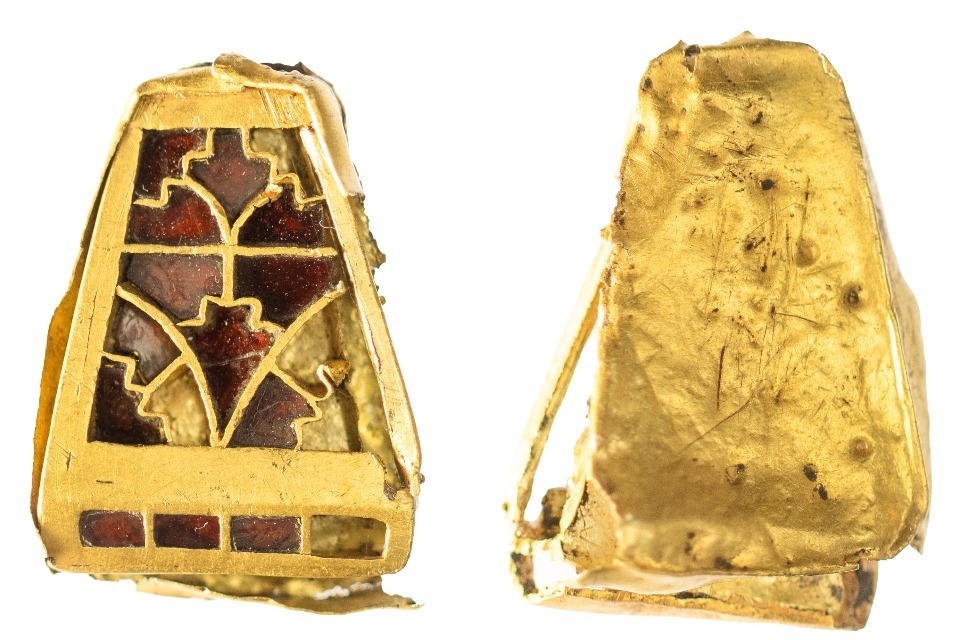- The panel is valued at almost £4,000
- The export bar has been placed to allow time for a UK gallery or institution to acquire the panel
An export bar has been placed on a rare Anglo-Saxon, Gold and Garnet Panel (c. 600-670) to provide an opportunity for a UK gallery or institution to acquire it for the nation.
The panel was discovered with a metal detector near Pocklington, East Riding of Yorkshire, on 6 March 2013 and has never been publicly exhibited.
The discovery of the panel near Pocklington is significant as it potentially offers insight into the study of artistic, political and cultural relationships between two of the most powerful kingdoms in 7th-century England, East Anglia in the east, and Northumbria in the north.
The item comprises a gold and garnet cloisonné panel of trapezoidal shape and displays clear links to the significant gold and garnet cloisonné metalwork from the Sutton Hoo ship burial and the Staffordshire Hoard.
The upper surface is filled with tiny interlocking cloisons or cells made from upright strips of gold soldered to a sheet gold backplate and filled with hand-cut garnets.
Arts Minister, Sir Chris Bryant said
Across the country, detectorists continue to make important discoveries, which help tell us the history of our nation.
This beautiful panel potentially holds information into how the mediaeval kingdoms of this country interacted and co-existed. I hope a UK buyer can be found so it can be studied further and its stories can be shared with the public.”
Committee Member Tim Pestell said
Amid the bitter politics of seventh-century England, rival kingdoms fought to gain power and prestige. An important way of expressing their resulting wealth was through delicate and technically complex pieces of jewellery like this example, found near Pocklington in Yorkshire. Using tiny hand-cut garnets set in gold cells or cloisons, the designs used in this example finds ready parallels in the better-known metalwork of Sutton Hoo and the Staffordshire Hoard. I hope that the bar placed on its export allows a museum to acquire this wonderful artefact as it has much yet to tell us about this pivotal period in English history.
The RCEWA Committee found the panel met the first and third Waverley criterion for its outstanding connection with our history and national life and its outstanding significance to the study of early mediaeval English regional society, English metalwork, the study of workshop practises, collaboration, and national and international exchange.
The decision on the export licence application for the panel will be deferred for a period ending on 23 March 2025 inclusive. At the end of the first deferral period owners will have a consideration period of 15 Business Days to consider any offer(s) to purchase the panel at the recommended price of £3,968 (inclusive of VAT of £128 [which can be reclaimed by an eligible institution]). The second deferral period will commence following the signing of an Option Agreement and will last for three months.
Notes to editors
- Organisations or individuals interested in purchasing the panel should contact the RCEWA on 02072680534 or rcewa@artscouncil.org.uk.
- Details of the item are as follows The object is a trapezoidal panel of unidentified function, perhaps from a larger composite object. It dates from the early to mid-7th century and is made from gold inlaid with garnets in the cloisonné technique. The object measures 21.3 mm in length, with a width of 7.3 mm (min) expanding to 14.9 mm (max), 2.8 mm thick and weighing 2.89 g. The maker is unknown, as is standard for metalwork of this period. It is in fairly good condition, with some damage to the gold framework. Nine of the original 14 garnets survive in situ.
- Provenance From the Collection of Dr Tony Abramson; Bonhams, Antiquities Sale, 2 October 2014, lot 140; Found at Pocklington area, East Yorkshire Recorded with the British Museum, ref. NLM-1A8B56 // 2013 T184
- The Reviewing Committee on the Export of Works of Art and Objects of Cultural Interest is an independent body, serviced by Arts Council England (ACE), which advises the Secretary of State for Culture, Media and Sport on whether a cultural object, intended for export, is of national importance under specified criteria.

